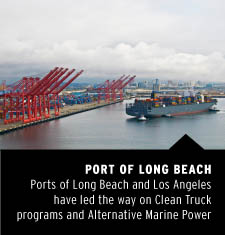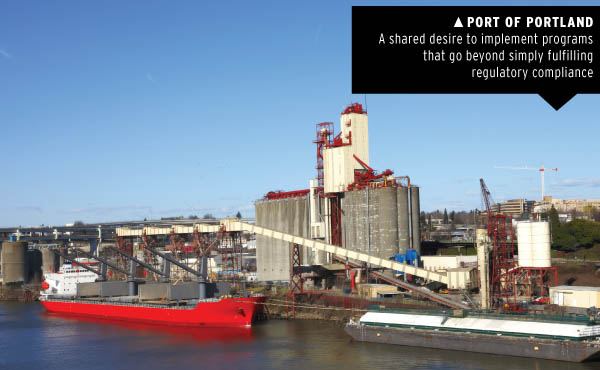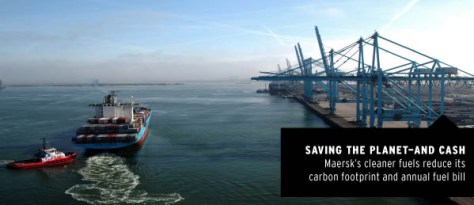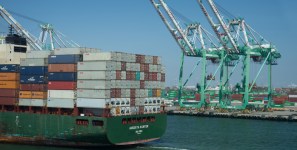SEA GREEN
SAVING THE PLANET, IT TURNS OUT, MEANS SAVING CASH. OCEAN CARRIERS AND PORTS NATIONWIDE ARE CATCHING ON, AND SHIPPERS ARE FINDING IT EASIER TO JOIN ECO-CONSCIOUS AMERICA.
If you’re looking for a great example of a port and a shipper working together to cut carbon emissions, consider Portland. There, Columbia Sportswear teamed with the Port of Portland to dredge the Columbia River Channel a modest-sounding three feet. Now 43 feet deep, the channel can handle ships bearing more cargo—another 6,000 to 10,000 tons of cargo per ship. That means fewer vessel trips. And that, of course, means less pollution—and cost-savings for shippers like Columbia Sportswear.
Today, the apparel manufacturer contracts with the port to move all of its products—about 3,500 containers annually—from its sources in Asia to markets throughout the U.S.
Portland’s motives are simple to explain, says Noeleen A. Tillman, executive director of the International Institute for Sustainable Seaports (I2S2) in Arlington, Virginia. Like every other port, Portland “has its own geography, financial capability and overall mission,” she says. “But there’s a shared desire to implement programs that go beyond simply fulfilling federal, state and local regulatory environmental compliance.”
Ports, she says, balance on a stool with three legs. There’s economics, of course, and the social considerations of the people who work in or live around ports. Now, of course, there’s a third consideration: the environment.
“The trend now is not just a focus on the environment but on a holistic approach that embraces the economic drivers as well as the community,” she says. One way that “holistic approach” has been put into play is what Tillman calls the out-of-the-box approach taken by the eight ports that form the West Coast Ports Technical Committee.
The good news for shippers is that calls to protect the planet often produce savings that fall straight to the bottom-line. Saving the planet, it turns out, means saving cash. That’s pushing a growing number of U.S. companies to reappraise each link in their supply chains. Ocean carriers and ports nationwide are catching on, and shippers are finding it easier to join eco-conscious America.
An affiliate of the American Association of Port Authorities (AAPA), Tillman’s group met in Long Beach, California, in February to begin the process of establishing a baseline of common sustainable design and construction guidelines for maritime and industrial growth. If you’re a green-minded shipper looking to partner with like-minded ports, you’ll appreciate their work.
• The Port of Houston Authority (PHA) is currently investing $1 billion in new cargo and cruise terminal facilities at Bayport with its site selection, design, construction and operations plans based on minimizing the impact on the local community. “Crafting a strategy for future development that balances sustainability and our need to remain attractive to shippers with cargo to move is key to our overall plan,” says John Moseley, the port’s general manager of trade development.
 • The nation’s first Clean Trucks program was instituted several years ago by the sister ports of Los Angeles and Long Beach. The plan has already taken more than 2,000 diesel-powered trucks off the road, reducing truck-related emissions by 80 percent. Both ports also blazed the trail for the use of Alternative Marine Power (AMP) that utilizes shore-supplied electricity to power a ship’s generators and reduce its diesel-engine emissions while in port.
• The nation’s first Clean Trucks program was instituted several years ago by the sister ports of Los Angeles and Long Beach. The plan has already taken more than 2,000 diesel-powered trucks off the road, reducing truck-related emissions by 80 percent. Both ports also blazed the trail for the use of Alternative Marine Power (AMP) that utilizes shore-supplied electricity to power a ship’s generators and reduce its diesel-engine emissions while in port.
• The South Carolina State Ports Authority is evaluating the use of cleaner fuels such as bio-diesel and ultra-low sulfur diesel by the port’s cargo-handling equipment, and recently launched a new voluntary program to help truck owners replace older trucks with newer, cleaner rigs.
• High on the list for the Port of Seattle is the reduction of air-polluting emissions and greenhouse gas (GHG) carbon emissions from all port operations by 50 percent from 2005 levels and “preventing sprawl” in less developed areas of Puget Sound by anchoring the region’s urban industrial land use.
But the very existence of ports would be meaningless without the ships that serve them—ships that, as one wag observed, “burn money, not diesel fuel.” With that in mind, how has sustainability effort shaped the relationship between ports and ocean carriers?
Ocean carriers operate on paper-thin profit margins, so “the key issue is the return on investment for the carriers,” says Tillman of 12S2. Fortunately for ocean carriers, as with other forms of cargo transportation, going green can often lead to savings in operational costs as well. So not only can sustainability initiatives help create positive feeling favor and win market share from like-minded shippers, they can also add to the bottom line. Some examples:
• APL has reduced its environmental footprint, including slow steaming and the use of emulsified and bio-diesel fuel, as well as such innovative technologies as ballast water treatment. “The key to our approach is assuring that we receive the best results for our environmental investments,” says Earl Agron, vice president of environment at APL.
• NYK is very active in implementing green technologies into its operations. In November 2007, the NYK Atlas became the first vessel in the NYK fleet to receive full shoreside power in November 2007 at Yusen Terminals, Port of Los Angeles. The company then began an initiative to install shoreside electric power units for its entire containership fleet.
• Last December, Hanjin Shipping introduced its supply chain carbon calculator. Shippers can access it to calculate the amount of CO2 emissions of their cargo per transportation segment—and in total—by inputting the origin, destination and weight of their shipment on the company’s website. “The calculator is helpful to retailers by offering the ability to evaluate shipping options,” says David Breen, air-quality program manager at the Port of Portland. “That knowledge enables them to make cleaner shipment choices for their cargo streams.”
• Maersk, the largest container carrier in the world, has developed various cleaner-fuel technologies that it says will not only reduce its carbon footprint, but could eventually lead to major savings on its annual fuel bill. The company recently entered into low-sulfur usage agreements at seaports around the U.S and the world, including at ports in California, the Pacific Northwest, Texas and Virginia.
The challenging economic climate, says the I2S2’s Tillman, “has had ports thinking that voluntary programs alone would steer carriers to competing ports.” But a few years ago, she says, there was a throw-down with ports offering incentives to attract carriers choosing to invest in green technologies and participate in their sustainability initiatives.
A prime example is the Port of Long Beach’s Green Flag Environmental Achievement Award, which is presented to individual ships when they attain 100 percent compliance with the port’s voluntary vessel speed-reduction program for a 12-month period. On the East Coast, the Virginia Port Authority offers a subsidy to offset increased fuel costs for carriers that use ultra low-sulfur marine gas oil or alternative power technology while their ships are moored at VPA-owned terminals. Maersk Line is the first carrier to take advantage of the program. Earlier this year, the carrier received $300,000 from the VPA to purchase the ultra low-sulfur marine diesel for one year. The fuel switch program will run for 13 months and eventually involve 41 Maersk ships that make upwards of 200 calls at VPA terminals every year.
But incentives aren’t just for ocean carriers. Shippers are also cashing in by partnering with ports that are greening their operations.
In 2009, the Port Authority of New York/New Jersey instituted an incentive program to encourage shippers to transport cargo via new rail routes. The port offers $25 per container to any company booking cargo on a railroad moving port cargo to or from specified rail origins or destinations, thereby reducing CO2 emissions. Not to be outdone, the Port of Los Angeles’ auto-import terminal, operated by Wallenius Wilhelmsen Logistics, became the first in the world to offer reduced tariffs and storage fees for zero-emission vehicles imported and exported through the 85-acre facility.
In addition to its fuel incentive for carriers, the Virginia Port Authority has created several tax incentive programs for shippers who move their cargo through the port, including tax credits for shippers who move cargo by barge or rail rather than by truck on Virginia’s highways; create new jobs or commit capital investment in the construction of international trade facilities as a result of moving cargo through a VPA-operated cargo facility; or manufacture or distribute manufactured goods (including processed agricultural products) that use the state’s public or private port facilities.
But perhaps the most effective program in the country to bring together these forgers of the global supply chain is the Coalition for Responsible Transportation (CRT).
Formed in 2007 in Sacramento, California, the group unites leading importers, exporters, trucking companies, clean truck manufacturers, logistics service providers, and ocean carriers who represent the largest, most progressive customers and service providers at U.S. ports.
The CRT’s green-conscious corporate members include Wal-Mart, Target, The Home Depot, Best Buy, Hewlett-Packard, JCPenney, Nike and Converse.
Through the group’s Clean Truck Initiative, the private-sector members of CRT are working in partnership with several of the country’s major ports to create “clean action plans” to develop and implement industry-supported clean truck programs that are both environmentally and economically sustainable.
“Every company is in business to stay in business and prosper,” says Thomas Phelps of Alloquor. “They’re learning that they can cut costs by reducing the number of links in their own supply chain and by working with partners along the entire chain that are genuinely trying to be more environmentally conscious.”
People see, he says, “that it’s the right thing to do.”






Leave a Reply